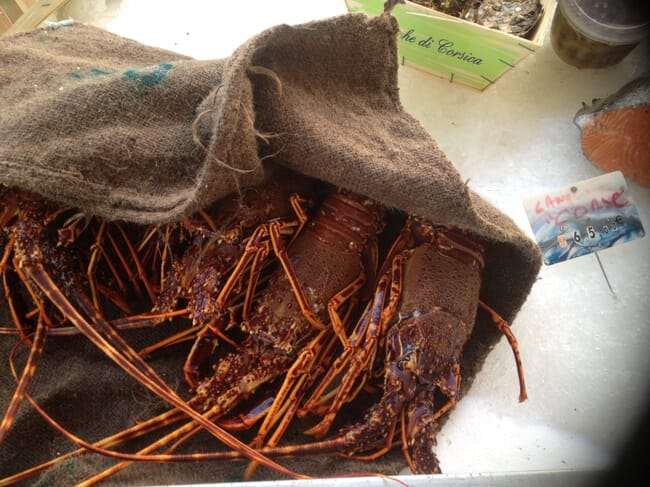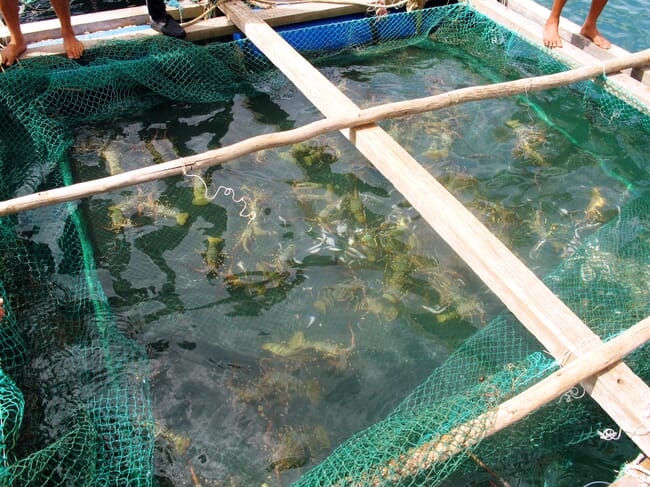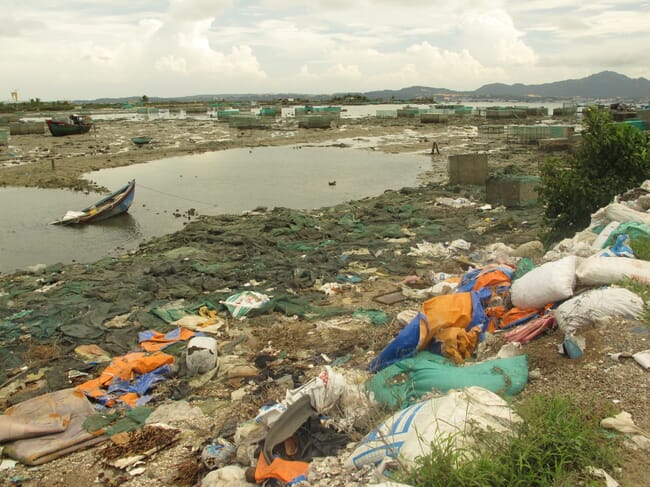Consider a marine crustacean species with one of the highest market values in a globally expanding seafood sector. A species where market supplies are entirely dependent on wild fisheries which are either already overfished, declining or simply not properly managed. Even worse, a species where climate change is already having very significant negative impacts on larval development, juvenile recruitment and disease susceptibility.

© David Fletcher
Global lobster fishery production is approximately 232,000 tonnes per annum, with about 66 percent of the trade comprising Homarus and Nephrops species, with Palinurid spiny lobsters accounting for 32 percent (FAO 2017). The wild harvest of lobsters has already reached maximum sustainable yield and, in some cases, exceeded it, based on the progressively declining harvests of several species (Sibeni & Calderini 2012).
At 146,000 tonnes in 2015, the American lobster (H. americanus) accounts for about 60 percent of world lobster landings with an average unit value of $20 per kg (FAO, 2017) although this price is very susceptible to trade tariffs. In contrast, global landings of spiny lobster species average 73,000 tonnes (FAO, 2017). The wealthier middle-class sector in China is a key market for H. americanus and is also a focus for exports from the well-managed fisheries of Australia and New Zealand (Ong & Mulvany, 2015). Such is the rising market demand, even with lobster export volumes to China increasing, prices were not adversely affected, with the price trend still gradually increasing (Western Australian Department of Fisheries/Economic Research Associates, 2015). Unitary prices paid in China for spiny lobster species are also well above the world average; spiny lobster from New Zealand fetches almost $90 per kg, and from Mexico and South Africa the average price is $40 per kg (FAO 2017).
Annual landings of European clawed lobster, Homarus gammarus, have averaged between 3,000 and 4,000 thousand tonnes over the last decade, with the main producers being the UK, Ireland and France. Depending on season, live H. gammarus secures up to twice as much as H. americanus. Landings of H. americanus had been increasing annually until 2017 when the globally important Maine fishery saw a 17 percent decline in production. There is significant concern about the future of this fishery, with climate change believed to be the key factor responsible for problems ranging from increased disease incidents to weakened juvenile recruitment (Groner et al., 2018; Waller et al., 2017). Climate change is also impacting several palinurid lobster fisheries (Briones-Fourzán & Lozano-Álvarez, 2015).
In Europe, the range of the European spiny lobster, Palinurus elephas, includes the western English Channel, Ireland, Brittany, Spain and Portugal. It was once one of the most important financial contributors to the inshore fishery sector. In Portugal, Spain, Ireland and UK, the P. elephas fishery has declined by between 85 and 95 percent in the last 70 years. Catches in Wales declined by 92 percent between 1980 and 1997, while Irish exports fell from 270 tonnes in 1959 to 20 tonnes (Tully 2011) and French Atlantic fisheries declined from 1,000 tonnes in the 1950s, to 25 tonnes in 2010 (Laurans et al., 2011). These trends reflect a catastrophic population crash in the Atlantic, where some fisheries, like those in Wales, are now commercially extinct. Weak management, coupled with poor biological knowledge of the species, has resulted in the EU fishery declining to an all-time low. The EU fishery has been described as “residual” (ICES, 2006). Meanwhile, in the UK, P. elephas is considered a key component of biodiversity by the Joint Nature Conservation Committee (JNCC) Annex I reef habitat, as essential for favourable conservation and good environmental status (GES) of reef habitats. Recovery of the P. elephas population is considered vitally important in gaining GES under the EU Marine Strategy Framework Directive (Leslie & Shelmerdine, 2012).

© David Fletcher
Culturing spiny lobsters
With future demand for lobsters expected to dramatically increase over the coming years, there is increasing interest in developing a sustainable supply of lobsters uncoupled from the harvest of wild populations through aquaculture production technologies (Phillips & Matsuda 2011; Smith, 2017). The improved design and understanding of high-rate recirculation aquaculture system (RAS) technology, coupled with the availability of quality crustacean larval feeds, has now made spiny lobster culture technically possible. The clawed lobsters of the Nephropoidea are generally aggressive in nature and not suited to controlled production in high-density grow-out systems. From a commercial perspective H. gammarus offers few attractive qualities for economic farming in land-based systems. Not only are Homarid lobsters aggressive but they are slow growing with the lowest market price of all lobster species. More importantly, the wild fishery is quite amenable to effective management and recovery when stocks become overfished. Consequently, any farmed H. gammarus would need to effectively compete with wild fishery supplies in the seafood market.
In contrast, Palinurid lobsters such as P. elephas (Plate 1), are far more susceptible to overfishing and recovery can be slow to non-existent for decades without strictly enforced protection over extensive areas of sea likely extending across several neighbouring EU border waters. This observation is related to the far more complex and extended planktonic cycle of P. elephas compared to H. gammarus, its more restricted habitat and its greater susceptibility to fishing pressure. With much reduced fishery landings and very slow recovery rates, prices for farmed P. elephas product would not have to compete with wild fishery supplies.
Several Palinurid lobsters possess characteristics essential for commercial farming in land-based farms using RAS technology essential for their culture. This is especially so in the UK with the higher energy and labour costs associated with using this technology. Naturally communal in behaviour, P. elephas will accept pelleted feeds and, although males can be aggressive during the mating season, mixed stock generally live in harmony and will breed in captivity. Some spiny lobster species can be held at high population densities (Phillips & Matsuda 2011) and, importantly, juveniles of some tropical species show enhanced growth under communal conditions (Marchese et al., 2019). If P. elephas is found to behave in a similar manner, this would be a key point in favour of its commercial culture – contrasting with H. gammarus, where individual animals must be isolated from point of juvenile settlement to market size.
On a unitary basis, P. elephas is also among the highest-priced seafood species in European and international seafood markets. Demand far outstrips supply, with market prices of €45 to €140 per kg for P. elephas on export to Asia. The Chinese market has an insatiable appetite for several spiny lobster species and as a result the first commercial hatchery for a tropical species is under construction in Australia – this follows the recent successful development of the hatchery technology for mass production of Panulirus ornatus juveniles. This success is seen as the basis for establishing a new industry with significant economic, social and environmental benefits. This will include job creation in commercial manufacturing and science, as well as providing opportunities for stock enhancement and improving understanding of how wild lobster stocks are effected by climate change (Smith, 2017).

© David Fletcher
Challenges
The single greatest obstacle to commercial culture of P. elephas is developing the hatchery technology for sustained juvenile production. However, such a high market entry point also makes this species an attractive candidate for farming. With the support of fishery-management tools such as marine protected areas (MPAs), commercial P. elephas hatcheries could also support the restocking of depleted Atlantic fisheries to benefit inshore small-scale fisheries – where in the decade to 2010 employment declined by 20-30 percent in the EU regional economy and by 30-50 percent in terms of income (Macfadyen et al., 2011). Simultaneous commercial farming will still be essential to meet market demand, support fishery restoration efforts and avoid unsustainable fishing pressure on recovering wild stocks.
Tropical spiny lobster culture, based on the capture and ongrowing of wild pueruli or juveniles in floating cages, was initiated in Vietnam as a high-risk, high-return venture focused on the tropical rock lobster Panulirus ornatus (Williams 2009). The industry peaked in 2006, with approximately 1,900 tonnes of production, before rapidly declining to a low of 720 metric tonnes in 2008, primarily due to disease outbreaks (Hung & Tuan 2009; Sibeni & Calderini 2012). Lobster ongrowing in Vietnam is associated with significant environmental degradation from organic waste due to use of trash fish and crustacean feeds (Plate 2); high levels of plastic pollution in coastal bays from discarded lobster-cage material (Plate 3); and the illegal importation of wild juvenile lobsters smuggled into the country from Indonesia. The cage-lobster culture sector in Vietnam is entirely dependent on wild caught juveniles, with the Indonesian strain of P. ornatus particularly favoured due to superior growth rates. While similar cage ventures have also been initiated in several other countries, all remain dependent on wild juvenile supplies (Sibeni & Calderini 2012).
Hatchery technology for H. gammarus has been established in the UK for decades and has received very significant national and EU financial support. In contrast, minimal funding has been expended on developing P. elephas hatchery techniques, despite the potential commercial value and former important ecological status of this species.

© David Fletcher
In 2012, RAS Aquaculture Research Ltd (RASAR) established a pilot R&D project to assess the not insignificant challenge of developing culture techniques for P. elephas. With over two decades of experience in identifying operational issues of commercial-scale RAS farms, and success with closing the larval cycles of other high-value crustacean species with extended planktonic cycles, RASAR was well placed to meet this challenge. In 2013, with grant support from the Wales Government and European Fisheries Fund (EFF), RASAR established Seiont Research Ltd and designed a purpose-built water-treatment system that enabled flexibility and precise control over key water-quality parameters. Following completion of the EFF funding in 2015 continued development work has been financed by RASAR.
P. elephas females generally commence egg hatching in January to February with each animal delivering between 50,000 and 250,000 larvae, or phyllosoma, according to female size (Galhardo et al., 2006). The phyllosoma are positively phototactic (ie, will move through the water in response to light) and good-quality phyllosoma will concentrate at the water surface for several days. They are almost totally transparent and undergo several moults until the juvenile is secured. The phyllosoma carapace has numerous delicate setae which are ideal for attracting fouling bacterial colonies which can inhibit subsequent moults. The phyllosoma are also especially susceptible to vibrio infestation of the gut which can readily cause total collapse of the culture.
During each successive season RASAR has improved culture techniques such that during the 2018 season all planktonic P. elephas phyllosoma stages (Plate 4) were produced, leaving just the final puerulus and juvenile stage to be secured. The project has identified a wealth of biological and reproductive data about P. elephas and has identified the optimal water-quality parameters and required water hydrodynamics in the phyllosoma culture tanks. Manipulation of the egg-hatching season is possible, and an approach to in-house production of viable fertilised eggs from captive broodstock has been developed which would enable future strain selection. The complex and protracted phyllosoma cycle of eight to nine months in the wild has been significantly reduced under laboratory conditions; a prototype artificial larval feed, attractive to the phyllosoma, is in early stages of development; and the very high mortality reported for P. elephas larvae during the early stages I to IV (Kittaka et al., 2001) has been resolved without recourse to antibiotics at any point in the larval cycle. This research is already contributing to improved understanding of wild P. elephas population recruitment in UK waters (Whomersley et al., 2018).
Further research is now required particularly to improve tank design for phyllosoma culture and enhance feed quality to overcome the final barriers to large scale juvenile production. Trials relating feed quality to the nutrient profile and performance of the phyllosoma have been expanded in 2018 in cooperation with the University of Highlands and Islands. This work is providing direction into appropriate diet formulations most suited to phyllosoma growth and survival to improve their transition to the resting puerulus stage and finally the juvenile lobster.
The culture of P. elephas is feasible but it must also be profitable at a commercial scale. Considering global demand for spiny lobsters amid declining global production, their commercial and ecological value, and the status of the wild P. elephas fishery in Europe further research into farmed production of this iconic species is warranted.




